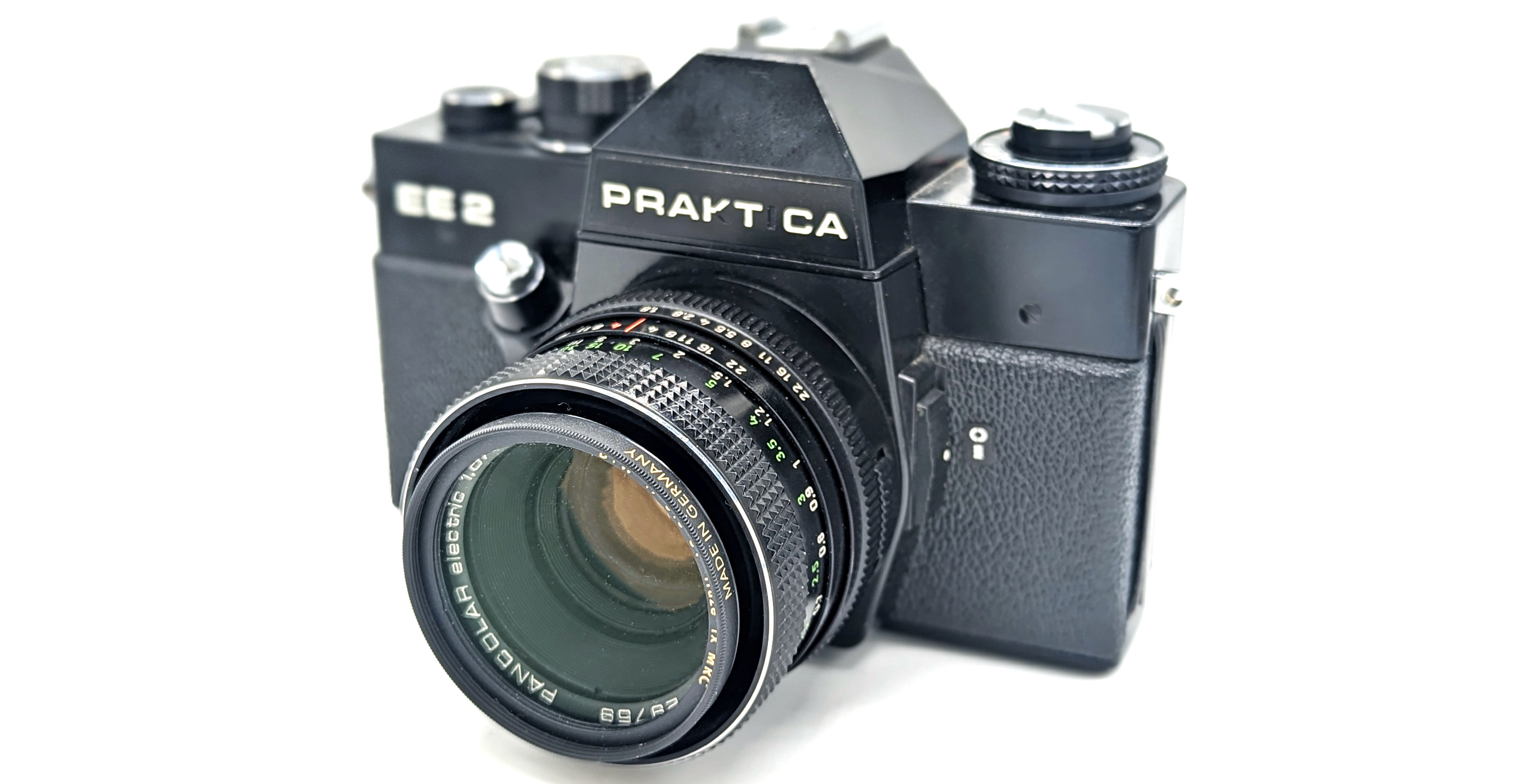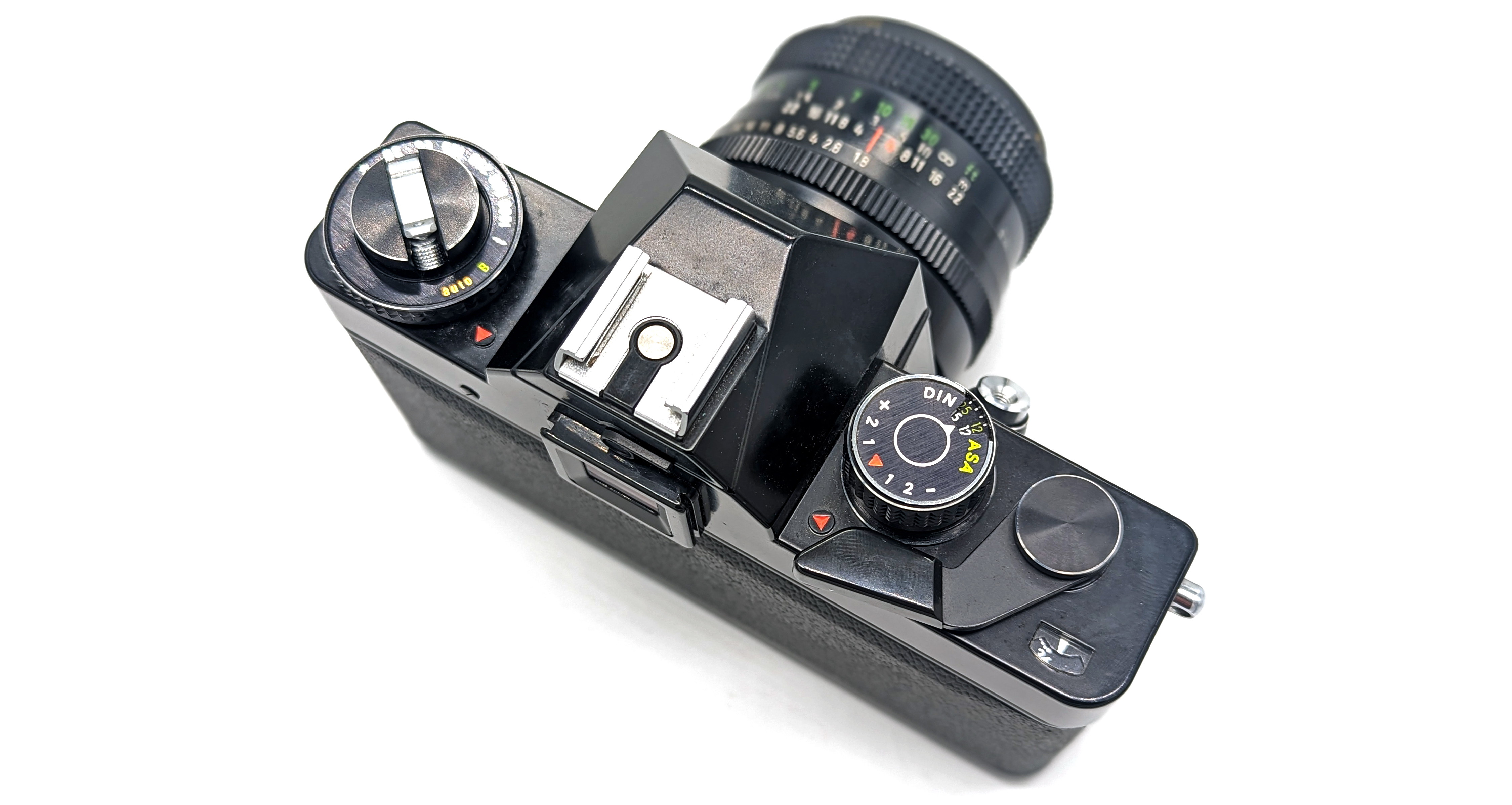
As the final model in the East German VEB Zeiss Ikon “Contax S” line, the 1958 Pentacon FM (aka the “Contax FM”) was the best of the bunch. With open aperture focusing with auto-diaphragm lenses, a nice ground-glass screen with a split-screen focusing aid, and in a relatively compact package, the FM may be the winner in the category of second generation M42 SLRs. Although the FM has some archaic operability, like a knob film advance, a non-instant-return mirror, an odd shutter speed dial, a lack of any kind of native or aftermarket provision for a cold shoe, and a front-mounted shutter button, its main draws include its size, weight, ergonomics, quality of its construction, and a fairly nice viewfinder for the time. Let’s take a look.
Not to recount unnecessarily the well-known history of the Contax S line, which is well-detailed elsewhere, let’s bring ourselves up to 1958. In 1949, Zeiss of East German introduced the “Contax S,” the first, or second depending on whom you ask, fixed pentaprism 35mm SLR. In 1952, Zeiss Ikon introduced the “Contax D,” which was successful and sold under various brand names around the world. During 1956, the “Contax E” was introduced, a “D” model with an added uncoupled selenium light meter on top of the pentaprism. Later in 1956, Zeiss Ikon introduced the “Contax F,” which was the first 35mm camera in production to allow open-aperture focusing with capable lenses, a major milestone in SLR development (to be fair, in 1956, those lenses did not really exist yet). The final variant, the 1958 “FM” would essentially be an “F” with a split-screen focusing aid. Rounding out the alphabet soup, Zeiss also produced the “FB,” an “F” with an uncoupled light meter and the “FBM,” an “FM” with an uncoupled light meter. Because of ongoing intellectual property disputes with Zeiss Ikon of West Germany, East German home market versions of these cameras were called “Contax,” while export versions were called “Pentacon.” In 1958, VEB Zeiss would become “VEB Kinowerke Dresden.” In 1959, this entity was then combined with several other East Germans companies. In 1964, this entity became “VEB Pentacon.” Thus, the Contax line ultimately was swallowed up by the company that had previously been manufacturing the competing Praktica FX series. The next major product of out this consortium was the 1959 Praktica IV, the first of the “next generation” of East German SLRs.
It would not be until about 1960 that M42 automatic diaphragm lenses would begin to hit the scene in earnest. Thus, the FM was often bundled with a “pre-set” lens, mostly the 50mm f/2.8 Tessar but could have come with a number of different East German-made standard lenses of the time. “Pre-set” lenses were a stopgap solution where you would set the minimum aperture you want on the lenses, and then another ring would allow you to switch from wide-open (for focusing) to your preferred aperture (for taking the photo). If you want my opinion, I generally prefer the later multicoated CZJ M42 lenses of the 1970s over any of the 1950s Tessars, Biotars, or whatever. Bundled with the Tessar, and if you could actually find one in North America (it appears that few were imported), the FM retailed for about $230 in 1958 but sometimes advertised as low as $160 (around $2,300 to $1,600 in today’s money).
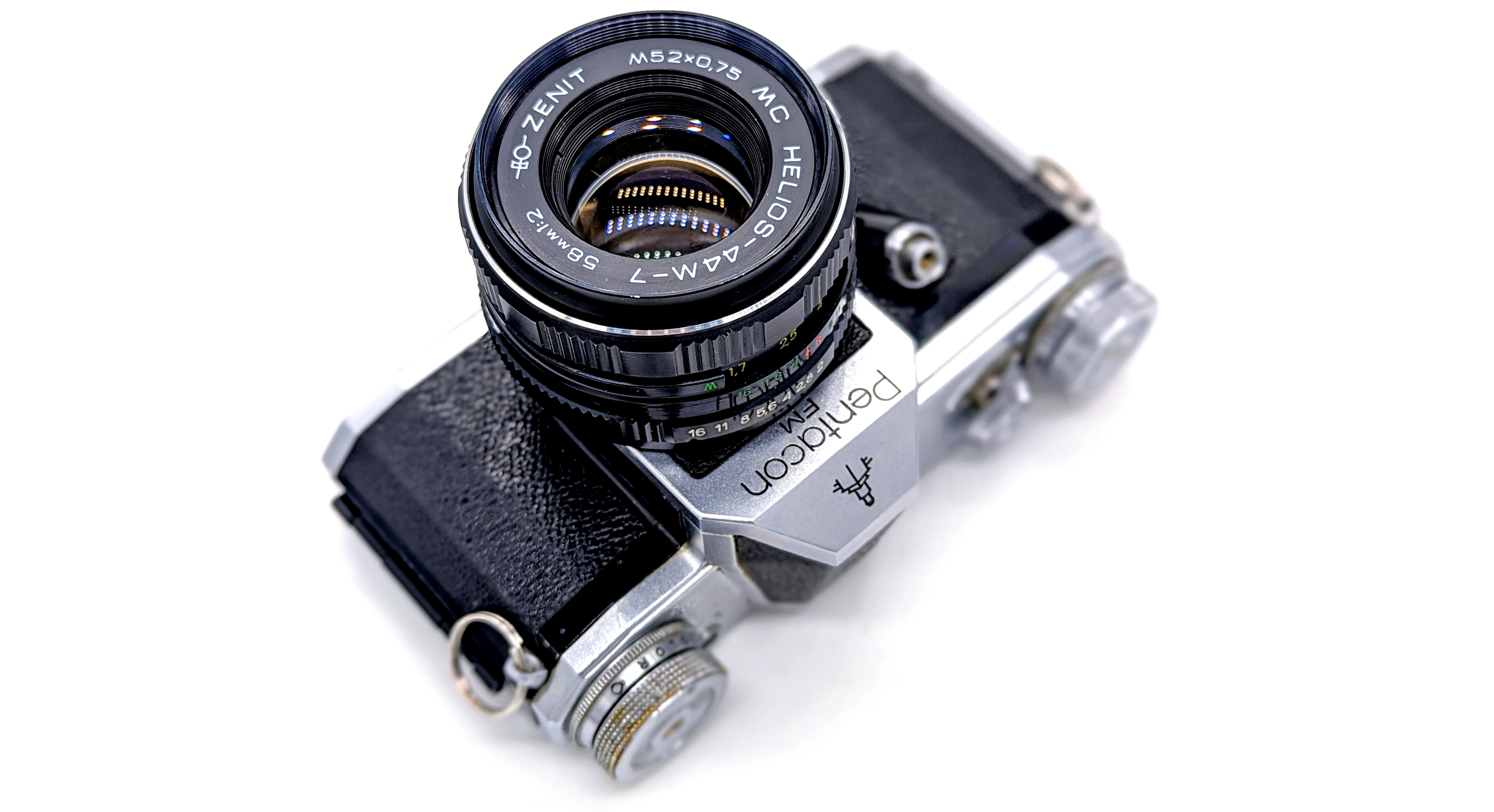
Here are the three of the top M42 SLRs of 1958 compared:
| Pentacon FM | Praktica FX3 | Asahi Pentax K | |
| Place of Manufacture | East Germany | East Germany | Japan |
| Lens Mount | M42 | M42 | M42 |
| Shutter Speeds | B, 1 sec – 1/1000 | B, 1/2 – 1/500 | B, 1 sec – 1/1000 |
| Fast/Slow Speeds | Switch Operated | Same Dial | Separate Dials |
| Auto-Diaphragm | Yes | Yes | Yes |
| Auto Return Mirror? | No | No | Yes |
| Prisms | Fixed Pentaprism | Interchangeable | Fixed Pentaprism |
| Film Advance | Knob | Knob | Lever |
| Stock Focusing Screen | Fresnel; Split-Screen | Ground Glass | Fresnel; Microprism |
| Weight | 620g | 620g | 570g |
| Standard Lens | Tessar 50mm f/2.8 | Tessar 50mm f/2.8 | Takumar 55mm f/1.8 |
| Shutter | Cloth Horizontal | Cloth Horizontal | Cloth Horizontal |
| X-Sync Speed | 1/20 | 1/50 | 1/50 |
| Price w/ Lens (1958-59) | @ $160 | @ $160 | @ $200 |
While it would have been nice to have a camera that combined the best features of these three, none of these three models clearly vanquished the competition. However, by 1958, great leaps forward in SLR technology were just a year or two in the future.
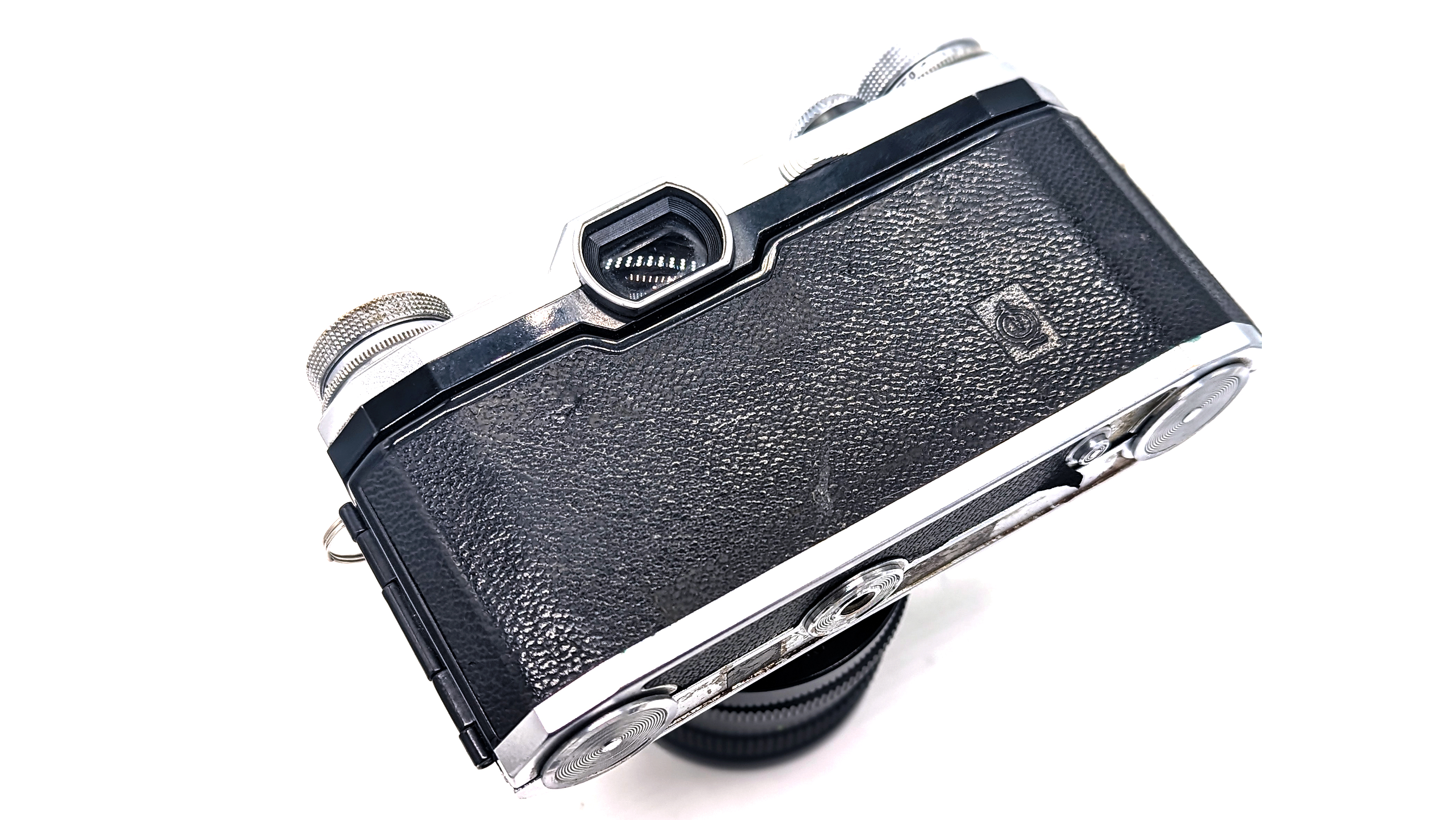
Operation
Being the final model, the FM incorporates everything good about the Contax S line and all of the upgrades that were incorporated along the way. Although much of its operation is archaic, its saving graces are the ability to use auto-diaphragm M42 lenses, a viewfinder with an incredibly bright center circle with a split-screen focusing aid, and exceptional build quality. I would say that if it were not for these three features, the FM would not be a worthwhile M42 user given the range of better alternatives. That all being said, how does it work?
Viewfinder: I was fully expecting that the viewfinder would be typical of 1950s and 1960s SLRs, quite dark even with a standard f/1.8 lens and pretty much unusable with slower aperture lenses. While the FM’s ground glass screen overall is not exceptionally bright, its center focusing spot is awesome. This makes a difference because with lenses slower than f/2, while the overall viewfinder dims significantly, the center spot remains bright. When using lenses that are f/2.8 and slower, the viewfinder outside of the center spot becomes fairly dim. While many M42 bodies do have center spot that is somewhat “brighter” than the rest of the focusing screen, they are nothing like the FM. Like the rest of the Contax S line, the focusing screens were not interchangeable. No other information is shown in the viewfinder.
Auto Diaphragm Operation: Although by the early 1960s, you could find auto-diaphragm M42 lenses in every corner drugstore, in 1958 they were a little hard to come by. The FM’s auto-diaphragm capability makes it compatible with every M42 lens from any manufacturer. The front-positioned shutter button may seem odd at first, but it is actually fairly ergonomic.
Shutter Speed Selection: Selecting the shutters speeds is another odd task. For starters, the FM uses the “old style” shutter speeds: 1/50, 1/100, 1/200, etc. That is not a big deal. To change the shutter speeds, you must first cock the shutter and then rotate a dial below the shutter speed window in the direction of the arrow. To use the slow speeds, a lever must be switched on the back and then you turn the dial for the slow speed to match the red arrow.
Shutter Sound: The FM’s shutter is fairly muted but has a slight metallic sound. The horizontal cloth shutter of the Contax S series has a fairly good reputation but remember that the material does not last forever.
Film Loading & Counter: The FM uses modern swing-back film loading. Interestingly, the Contax S series had this idea that you could use another film cartridge as a kind of take-up spool, which would eliminate the need to rewind the film into the original canister. The film counter is located on the advance knob and does not reset automatically. After loading the film, you set the film counter dial to two spots short of “0” and then shoot / wind the film until the counter reaches “1.”
Film Advance: Although adding a lever would have been easy enough, the FM sticks to a clockwise rotating knob. Because the FM does not have an automatic return mirror, rotating the knob will both lift the mirror back into position and cock the shutter for the next shot.
X-Flash Sync: 1/20 is a rather abysmal flash x-sync speed, even for the 1950s. The sync speed may not even matter anyway because there is nowhere to put a flash. The Contax S line lacked either a native or aftermarket cold shoe option.
Accessories: The FM did not have a super large range of proprietary accessories. Of note, they included a rubber eyecup, extension rings for close-up photography, an angle finder, a leather case, and a microscope adapter. None of these are essential.
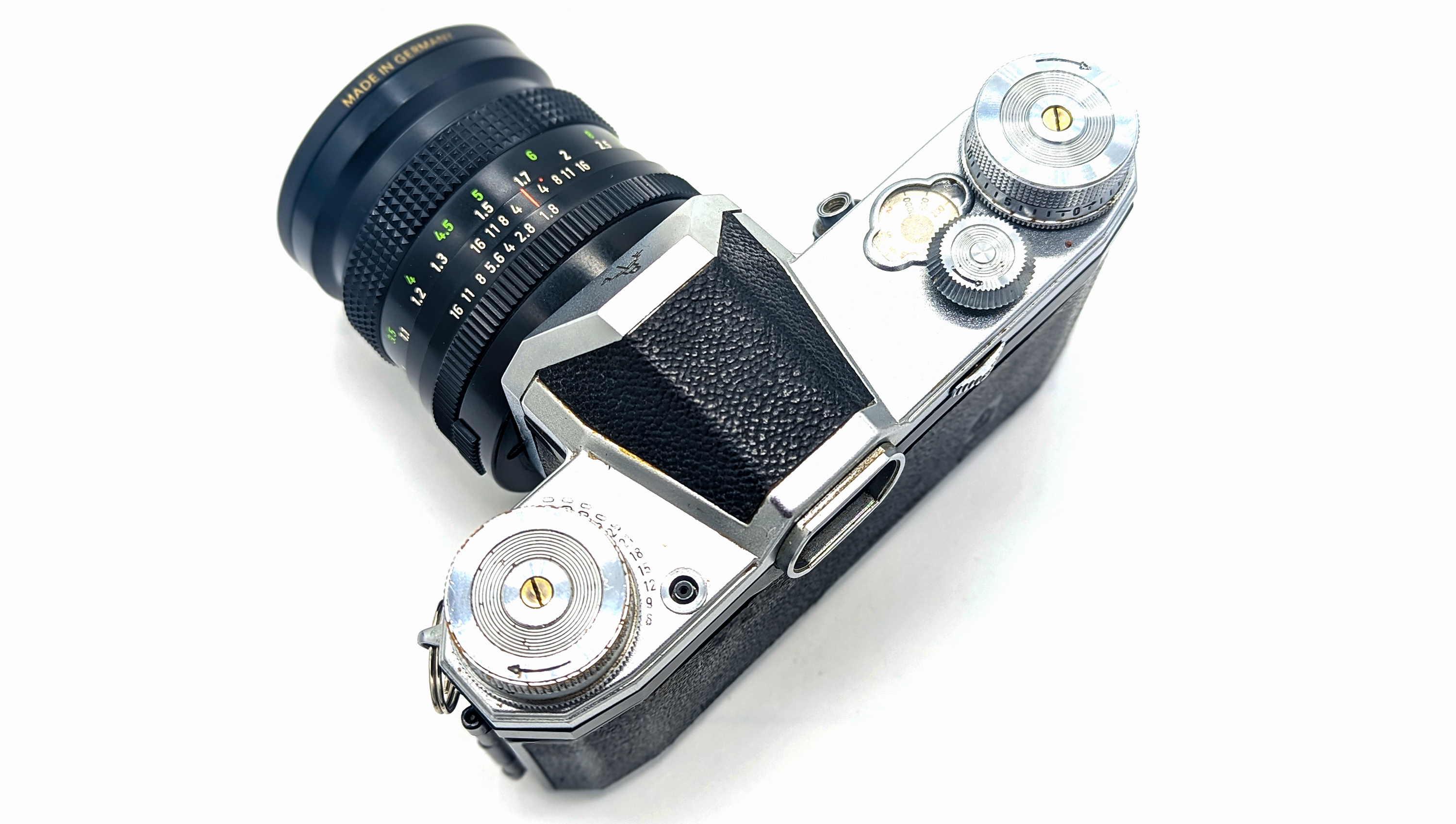
Conclusion
If considering a Pentacon / Contax FM as a shooting platform for M42 lenses, rather than as a shelf queen or conversation piece, it is difficult to make a compelling case versus subsequent generations of cameras. However, despite its quirky operation, I like the FM. It is not only an elegant machine from a bygone age, but the center spot alone provides a brighter view than 98% of M42 bodies’ focusing screens (maybe all of them). The FM remains a difficult camera to find in working condition, so expect that any long-neglected body will require some repair.
